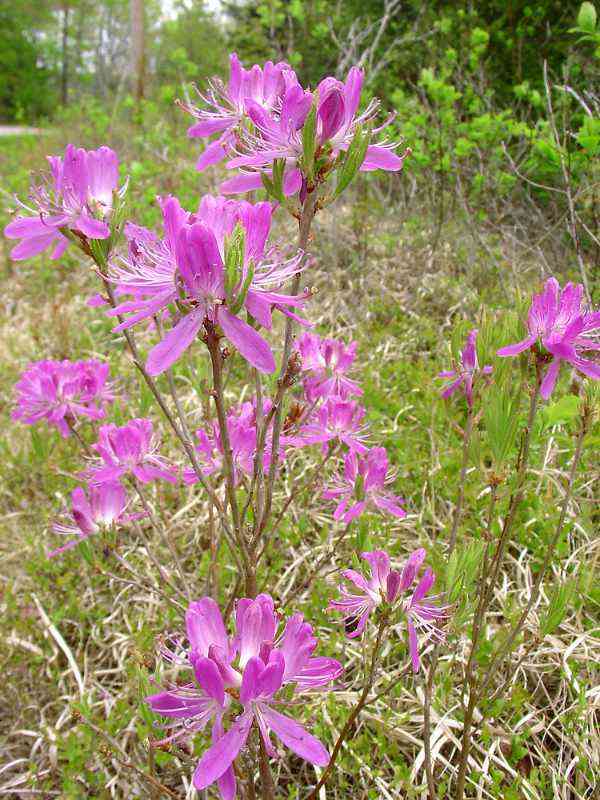Rhodora

Rhodora is a thin, erect-branched shrub that seldom grows taller than 3-4 feet. This small northern shrub has stunning blooms that appear before or alongside the leaves. Rhodora canadensis, also known as Canada rosebay, is a deciduous shrub native to northeastern North America and a member of the heath family. It is most commonly found in swampy areas and grows to a height of about 90 cm (3 feet). Rhodora is from the Canadian Maritimes, as well as Ontario, Pennsylvania, and New Jersey to the north.
The name is derived from the former genus name Rhodora when its peculiar, tubeless blossoms led to the assumption that it belonged in its own genus. This azalea blooms in the wild in early to late May and mid-June for the populations at higher elevations, signaling the start of summer.
Quick Growing Guide
Botanical Name: Rhododendron canadense
Also Called: Canada rosebay
En français: Rhododendron du Canada
Colour:
Blooms:
Sun / Shade:
Height:
Pollinators:
Appearance
The plant has smooth-edged, alternating, oval or oblong leaves that are 3.75–5 cm long or 1.5-2 inches. The underside is hairy and grey. Before the leaves emerge in the spring, the eye-catching rosy-purple blossoms are about 4 cm (1.6 inches) broad.
They bloom in the early spring, bringing life to the garden and establishing the groundwork for other living things early in the season with their vibrant blossoms that entice butterflies and hummingbirds. Additionally, you can use their flowers to make floral arrangements for room decor.

How to Care for Rhodora canadense Care
Anyone planning to grow Phodora should try to mimic the original habitat’s growing conditions as closely as possible. Here are some crucial details about rhododendron maintenance.
Rhodora can be planted in the spring or fall. The seeds take a very long time to develop into shrubs. Therefore, buying seedlings or potted plants is the best option. Make sure there is 61 cm between plants if they are planted in a garden. Create a planting hole that is three times as wide as Rhodora’s root ball. The root crown should be level with the earth, and the roots cannot be sunk too deeply. Water the planting pit once when the soil is halfway full.
Water
Rhodora dislikes extreme temperatures. It may thrive in a climate with temperatures between 12 and 25 °C. The plants develop slowly and go into dormancy at temperatures above 30 °C or below five °C. Rhodora will experience frost damage at temperatures below three °C. They require an adequate supply of slightly acidic water. Too much water that has gathered cannot be supported.
Sunlight for Rhodora
Rhodora can be grow in areas with lots of sunlight, but they must be shielded from direct sunlight. It is advised that 75% of the sun’s rays be exposed in the spring to avoid sunburning the new leaves.
Rhodora Soil
Rich, loose, and somewhat acidic soil is ideal for Rhodora. The soil needs good drainage because plants do not enjoy storing too much water. Good options include fully decomposed groundwood, leaf mold, pine needle mulch, peat soil, and moss. These are all highly draining acidic culture media. You cannot utilize soil that is alkaline or gummy.
These plants prefer soil that has a pH between 4.5 and 6. It is recommended to check your soil’s pH level before planting. You can moderately add an acidic fertilizer, such as aluminum sulfate if it is only somewhat alkaline. Before planting Rhodora, combine it with the original soil and make sure the pH is within the acceptable range.
Fertilizing Rhodora
The use of base fertilizer when planting Rhodora can improve outcomes. Apply a monthly dose of water-soluble fertilizers to plants that are actively growing. Apply phosphate fertilizer prior to blossoming to lengthen the flowering period and increase flower size and color. 2-3 times every ten days, apply fertilizer. Use nitrogen fertilizer to encourage leaf growth after blooming.
On sunny days, fertilizer needs to be applied several times in modest amounts in the evening. Apply the fertilizer only if the soil is completely dry, then water the plant the next day. When the weather is hot and when plants are hibernating in the winter, stop fertilizer.
Pruning
After Rhodora’s blossoms have faded, prune them. To maintain healthy growth, promptly prune old, dry branches or ones that have illnesses. Branches can be pruned to create better shapes if they are excessively long, have excessive growth, or bend.
Harvest
Rhodora flowers should be gathered for cutting, with an emphasis on those that are still in the early stages of bloom. These flowers are more lovely and last longer to be savored. Clipped the bottom of the branch diagonally with a sharp knife to expand the surface area where the cut bloom can absorb water. Don’t expose the blooms to direct sunlight to increase bottle life. When changing the water, always cut the bottom of the cut flower in an oblique direction.
Pollinators
Rhodora flowers are well adapted to pollination by female bumblebees. These insects, which are active early in spring, are the only pollinators around when this plant flowers.
Relation with Nature
Many different butterflies, flies, and bees are drawn to these blooms. Rhodora has a special bond with the rare bog elfin butterfly that consumes its nectar after hatching. They only eat the neighboring leaves of the black spruce as a caterpillar. Another unusual connection is with the Columbia silkmoth, which uses Rhodora as a host plant for its larvae. Deer do not consume this plant, probably as a result of the leaves’ hairiness.